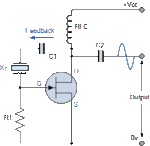Eshal
Advanced Member level 1
- Joined
- Aug 29, 2012
- Messages
- 470
- Helped
- 16
- Reputation
- 32
- Reaction score
- 15
- Trophy points
- 1,298
- Location
- Nowhere :)
- Activity points
- 5,149
Follow along with the video below to see how to install our site as a web app on your home screen.
Note: This feature may not be available in some browsers.
 Pierce Oscillator
Pierce OscillatorEshal said:...
Why RFC is being used here?
Is there any specific difference between RFC and an inductor? Why it is not called an inductor?
It blocks high frequency oscillations where to go?In this circuit it is called an RFC because that is its function. It essentially provides a very high impedance to your high frequency oscillations, but allows the DC supply to pass through.
An inductor has a high impedance at high frequencies (its reactance rises when the frequency rises). Then a transistor with an inductor as its collector load and has its emitter grounded has a high voltage gain at high frequencies.It blocks high frequency oscillations where to go?
It blocks high frequency oscillations where to go?